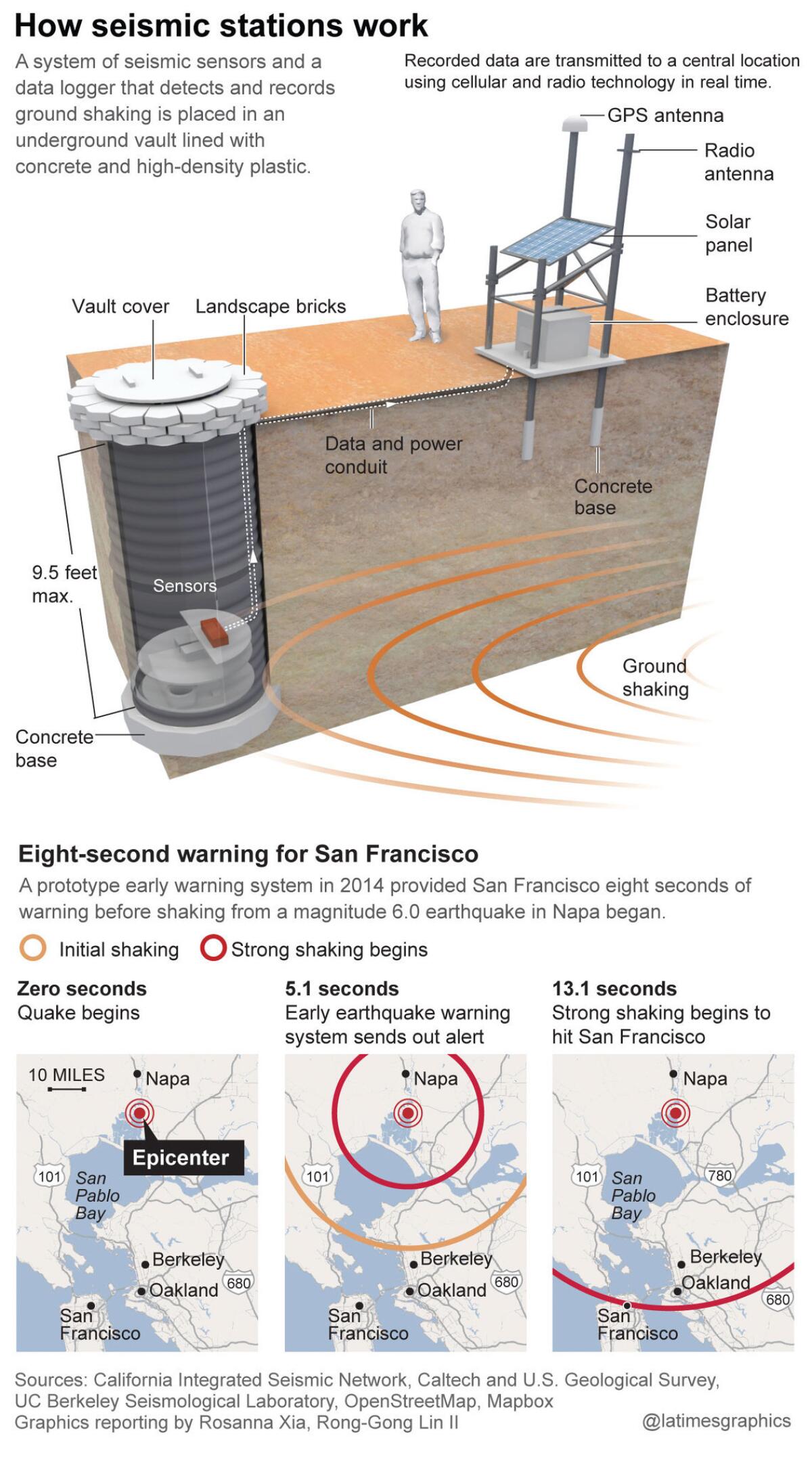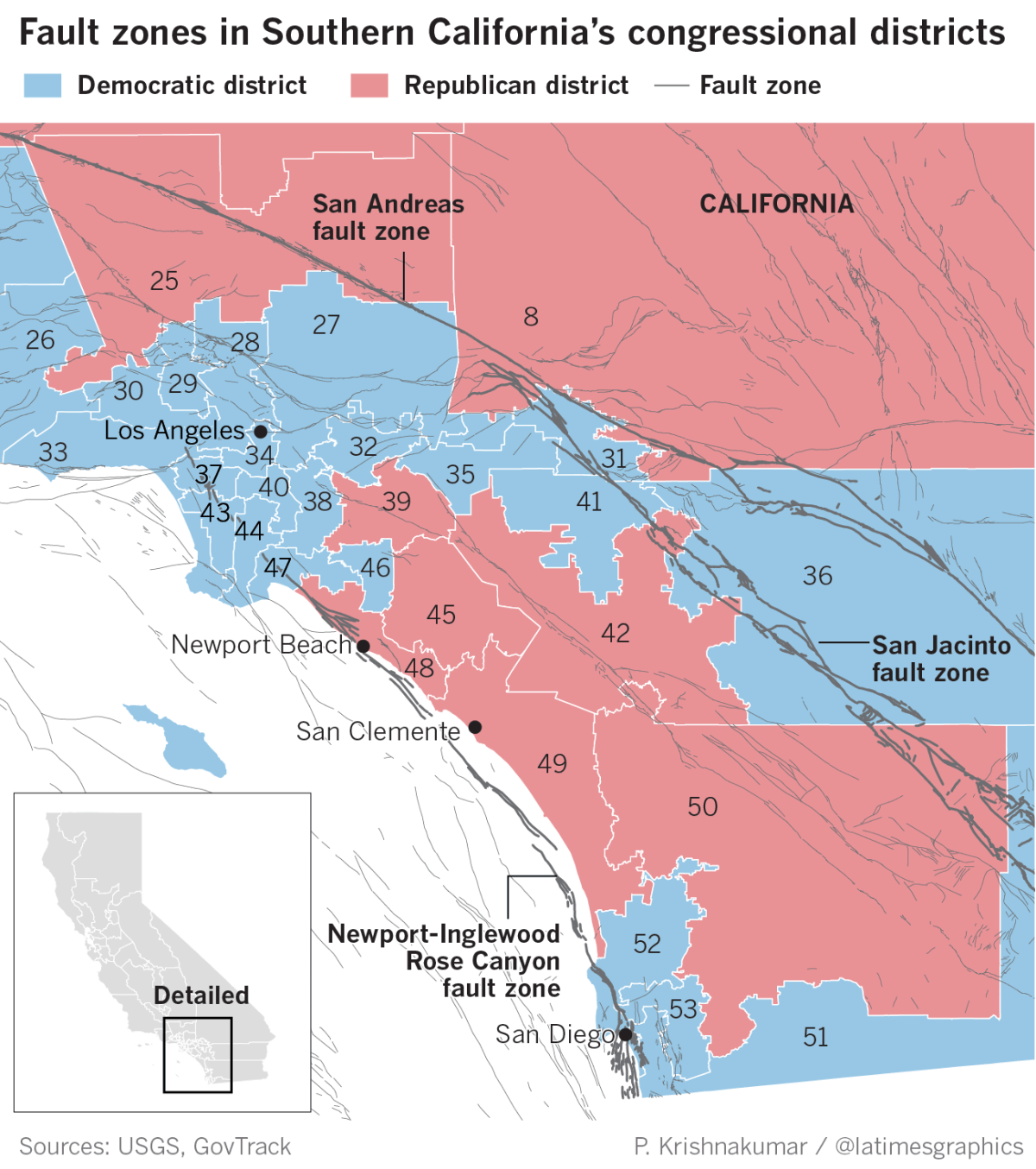Trump again seeks to end funding for earthquake early warning system

Mexico City got a substantial warning before the shaking from a distant earthquake arrived Friday — some 30 to 60 seconds broadcast over loudspeakers from an earthquake early warning system.
It was another success for Mexico City’s earthquake warning system — one which California, Oregon and Washington state still lack, and one that is an ongoing target for elimination by President Trump.
The Trump administration’s budget proposal released last week again zeroed out funding for the earthquake early warning program administered by the U.S. Geological Survey.
The president’s budget proposal for the fiscal year that begins Oct. 1 requested about $13 million less for the federal government’s earthquake hazards program, including $10.2 million for the earthquake early warning program. The administration also proposed reducing staff for the USGS’s earthquake hazards program from 240 to 222, including 15 positions that staff the earthquake early warning program.
The U.S. Department of the Interior, which oversees the USGS, said in its budget justification that the reduction in the earthquake hazards program was proposed to “address higher priorities.”
Representatives from California said they would move to keep funding the program.
“A functioning earthquake early warning system can provide critical life-saving benefits, which is why there’s broad bipartisan support to fund it in Congress,” Rep. Ken Calvert (R-Corona), chairman of an appropriations subcommittee that oversees funding for the USGS, said in a statement. “I will continue to advocate for the development and funding for the earthquake early warning system. This is a system the West Coast needs to have in place.”
Rep. Adam Schiff (D-Burbank) said the USGS’s ShakeAlert system would protect property and infrastructure.
“Congress has remained steadfast in its bipartisan support for the system, and I will work to see that Congress resumes funding for the project just as we did last year when the budget zeroed it out,” Schiff said in a statement.
This is the second consecutive budget the Trump administration has proposed zero funds for the earthquake early warning system. Congress reversed Trump’s proposal to end development of the early warning system from the administration’s first proposed budget.
The USGS has been working on an earthquake early warning system for years, but the system remains short on funds. It’s estimated that the system will cost at least $38 million to build for the West Coast and $16 million annually to operate and maintain.
Nevertheless, the USGS has said it plans to begin limited public alerts of the early warning system by the end of this year, as long as funding isn’t cut. Southern California is one area where the network of seismic sensors is dense enough to begin early warnings.
One company, Santa Monica-based Early Warning Labs, is in final stages of testing a smartphone app that would offer users early warnings from the USGS from their phone, and is planning on starting a limited public release in Southern California this summer; the company is already accepting requests on their website to get the app once it’s ready.
“We’re going to be slowly adding test users,” said Josh Bashioum, founder of Early Warning Labs. A broader roll-out will come with some challenges, such as whether the Apple and Android systems will suffer push notification delays when tens of thousands are sent at the same time to the same geographical area. That’s why the release of the app will come in phases, Bashioum said.
For the system to go live across the West Coast, more sensors still need to be installed in Washington, Oregon and sparsely populated areas of Northern California. More than 850 earthquake sensing stations are online, but about 800 more are needed. Too few sensors would mean, for instance, that Los Angeles could also see warning delays in an earthquake that starts in Monterey County and barrels south along the San Andreas fault.
Funding is in place for 250 more stations over the next year and a half, which will make California’s seismic early warning network 74% complete, while the Pacific Northwest’s will be 51% built out. Besides Southern California, areas of high sensor density include the San Francisco Bay and Seattle areas.
Along the West Coast, facilities of all types are testing or planning to test the earthquake early warning system, including airports, oil refineries, pipelines, schools, universities, city halls and libraries.
Hospitals in California, for instance, are testing audible notifications broadcast from fire alarm equipment so surgeons can remove scalpels and staff can shut off electric cauterizers to prevent fire. Condominium towers testing the earthquake early warning system have been similarly rewired, which would allow residents time to drop, cover and hold on before shaking arrives.
Hospitals are also working to shut down coolant systems automatically, which if broken during an earthquake could release toxic chemicals throughout the building.
Some office buildings have also been wired to automatically bring elevators to the next available floor, preventing people from being trapped after an earthquake. Internet-connected desk phones at a few offices at Santa Monica College have been turned into warning systems, sending out audio and visual alerts that warn of an incoming earthquake.
In Los Angeles County, rail operators for the Metropolitan Transportation Authority are now trained to stop when they hear word of an earthquake early warning from the control center. The San Francisco Bay Area Rapid Transit system is wired to automatically slow down trains when its computer system receives word of an incoming earthquake.
And the radio system at Universal Studios and Universal City’s fire station is programmed to alert critical staff of expected shaking and allow firefighters to open garage doors before a possible power outage makes them inoperable.
The system has worked in other countries besides Mexico.
On Feb. 6, Taipei had 11 seconds of warning broadcast on television before the shaking from a magnitude 6.4 earthquake off Taiwan’s east coast hit the capital, according to the website Temblor.
During the 2011 magnitude 9 earthquake in Japan, viewers in Tokyo watching an NHK television channel that blared the early warning had more than a minute of notice before the strongest shaking arrived.
The system works on a simple principle: The shaking from an earthquake travels at the speed of sound through rock — slower than the speed of today's communications systems. That means it would take more than a minute for, say, a magnitude 7.8 earthquake that starts at the Salton Sea to shake up Los Angeles, 150 miles away, traveling on the state's longest fault, the San Andreas.


Southern California congressional districts
| Congressional district | Representative | Party |
|---|---|---|
| Congressional district8 | RepresentativePaul Cook | PartyRepublican |
| Congressional District25 | RepresentativeSteve Knight | PartyRepublican |
| Congressional District26 | RepresentativeJulia Brownley | PartyDemocrat |
| Congressional District27 | RepresentativeJudy Chu | PartyDemocrat |
| Congressional District28 | RepresentativeAdam Schiff | PartyDemocrat |
| Congressional District29 | RepresentativeTony Cárdenas | PartyDemocrat |
| Congressional District30 | RepresentativeBrad Sherman | PartyDemocrat |
| Congressional District31 | RepresentativePete Aguilar | PartyDemocrat |
| Congressional District32 | RepresentativeGrace Napolitano | PartyDemocrat |
| Congressional District33 | RepresentativeTed Lieu | PartyDemocrat |
| Congressional District34 | RepresentativeJimmy Gomez | PartyDemocrat |
| Congressional District35 | RepresentativeNorma Torres | PartyDemocrat |
| Congressional District36 | RepresentativeRaul Ruiz | PartyDemocrat |
| Congressional District37 | RepresentativeKaren Bass | PartyDemocrat |
| Congressional District38 | RepresentativeLinda Sánchez | PartyDemocrat |
| Congressional District39 | RepresentativeEdward Royce | PartyRepublican |
| Congressional District40 | RepresentativeLucille Roybal-Allard | PartyDemocrat |
| Congressional District41 | RepresentativeMark Takano | PartyDemocrat |
| Congressional District42 | RepresentativeKen Calvert | PartyRepublican |
| Congressional District43 | RepresentativeMaxine Waters | PartyDemocrat |
| Congressional District44 | RepresentativeNanette Barragán | PartyDemocrat |
| Congressional District45 | RepresentativeMimi Walters | PartyRepublican |
| Congressional District46 | RepresentativeLuis Correa | PartyDemocrat |
| Congressional District47 | RepresentativeAlan Lowenthal | PartyDemocrat |
| Congressional District48 | RepresentativeDana Rohrabacher | PartyRepublican |
| Congressional District49 | RepresentativeDarrell Issa | PartyRepublican |
| Congressional District50 | RepresentativeDuncan Hunter | PartyRepublican |
| Congressional District51 | RepresentativeJuan Vargas | PartyDemocrat |
| Congressional District52 | RepresentativeScott Peters | PartyDemocrat |
| Congressional District53 | RepresentativeSusan Davis | PartyDemocrat |
Times staff writer Kate Linthicum in Mexico City contributed to this report.
Sign up for Essential California
The most important California stories and recommendations in your inbox every morning.
You may occasionally receive promotional content from the Los Angeles Times.








